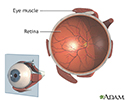Central serous choroidopathy
Central serous retinopathy; Central serous chorioretinopathy
Central serous choroidopathy is a disease that causes fluid to build up under the retina. This is the back part of the inner eye that sends sight information to the brain. The fluid leaks from the blood vessel layer under the retina. This layer is called the choroid.
Causes
The cause of this condition is unknown.
Men are affected more often than women, and the condition is most common at around age 45. However, anyone can be affected.
Stress appears to be a risk factor. Early studies found that people with aggressive, "type A" personalities who are under a lot of stress may be more likely to develop central serous choroidopathy.
This condition can also occur as a complication of steroid drug use.
It has recently been reported after vaccination for COVID-19, although cause and effect could not be proven.
Symptoms
Symptoms may include:
- Dim and blurred blind spot in the center of vision
- Distortion of straight lines with the affected eye
- Objects appearing smaller or farther away with the affected eye
Exams and Tests
Your health care provider can most often diagnose central serous choroidopathy by dilating the eye and performing an eye exam. Fluorescein angiography confirms the diagnosis.
This condition may also be diagnosed with a noninvasive test called ocular coherence tomography (OCT).
Treatment
Most cases clear up without treatment in 1 to 2 months. Laser treatment or photodynamic therapy to seal the leak may help restore vision in people with more severe leakage and vision loss, or in those who have had the disease for a long time.
People who are using steroid medicines (for example, to treat autoimmune diseases) should stop using these medicines, if possible. Do not stop taking these medicines without first talking to your provider.
Treatment with non-steroidal anti-inflammatory (NSAID) eye drops may also help.
Outlook (Prognosis)
Most people recover good vision without treatment. However, vision is often not as good as it was before the condition occurred.
The disease returns in about one half of all people. Even when the disease returns, it has a good outlook. Rarely, people develop permanent scars that damage their central vision.
Possible Complications
A small number of people will have complications from laser treatment that impair their central vision. That is why most people will be allowed to recover without treatment, if possible.
When to Contact a Medical Professional
Contact your provider if your vision gets worse.
Prevention
There is no known prevention. Although there is a clear association with stress, there is no evidence that reducing stress can help prevent or treat central serous choroidopathy.
References
Fowler N, Mendez Martinez NR, Pallares BV, Maldonado RS. Acute-onset central serous retinopathy after immunization with COVID-19 mRNA vaccine. Am J Ophthalmol Case Rep. 2021;23:101136. PMID: 34151047 pubmed.ncbi.nlm.nih.gov/34151047/.
Lam DSC, Boon CJF, Radke NV, van Dijk EHC. Central serous chorioretinopathy. In: Sadda SVR, Sarraf D, Freund KB et al, eds. Ryan's Retina. 7th ed. Philadelphia, PA: Elsevier; 2023:chap 73.
Ng C, Kalevar A, Agarwal A. Central serous chorioretinopathy. In: Yanoff M, Duker JS, eds. Ophthalmology. 6th ed. Philadelphia, PA: Elsevier; 2023:chap 6.26.
Tamhankar MA. Visual loss: retinal disorders of neuro-ophthalmic interest. In: Liu GT, Volpe NJ, Galetta SL, eds. Liu, Volpe, and Galetta's Neuro-Ophthalmology. 3rd ed. Philadelphia, PA: Elsevier; 2019:chap 4.
Review Date: 7/9/2024





